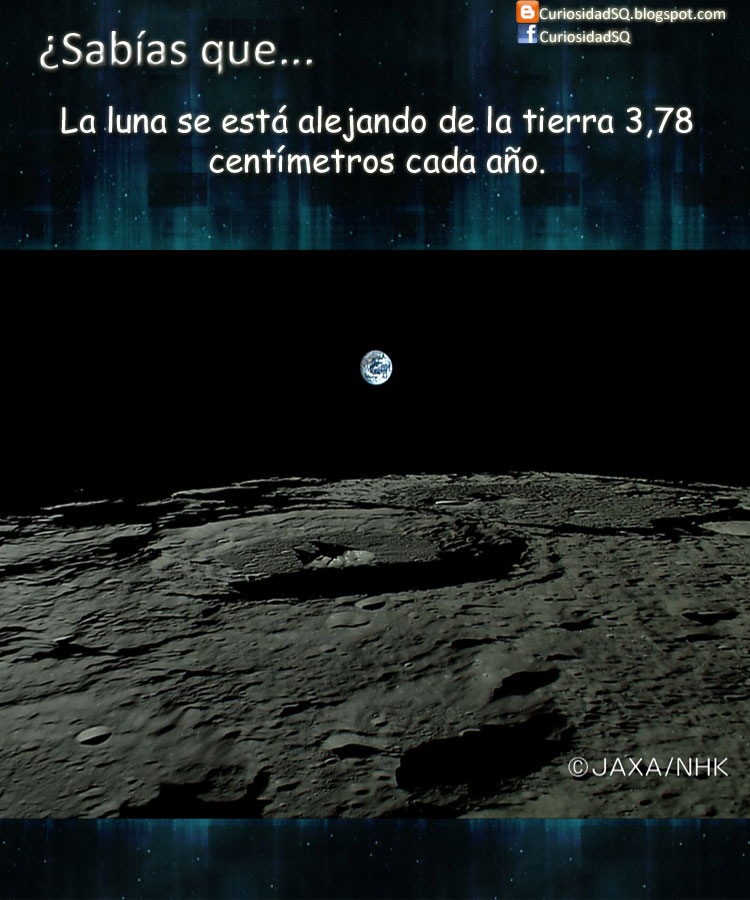La Luna Se Aleja de la Tierra: The Moon is Drifting Away
Have you ever gazed up at the night sky and felt a sense of wonder at the moon's ethereal glow? This celestial companion, a constant presence in our lives, holds more secrets than meet the eye. Unbeknownst to many, the moon is slowly but surely moving away from us, a phenomenon known as "la luna se aleja de la tierra" in Spanish.
It might sound like something out of science fiction, but this lunar retreat is a scientific reality. Every year, the moon distances itself by about 3.8 centimeters, roughly the size of your thumb. While this might seem minuscule considering the vastness of space, over millions of years, this gradual drift will have significant consequences for our planet.
This subtle shift in the cosmic dance between Earth and its moon is driven by the complex interplay of gravity and tidal forces. As the moon orbits our planet, its gravity tugs on Earth's oceans, creating bulges of water that we experience as tides.
These tidal bulges, however, are not perfectly aligned with the moon's gravitational pull. Due to Earth's rotation, the bulges are slightly ahead of the moon's orbit. This misalignment results in a subtle gravitational "push" on the moon, transferring energy from Earth's rotation to the moon's orbit.
This energy transfer has two primary effects. First, it causes Earth's rotation to slow down, meaning our days are getting slightly longer over time. Second, it causes the moon to spiral outward, increasing its distance from Earth. This process, while incredibly slow, has been ongoing for billions of years.
While the immediate effects of the moon's retreat are imperceptible in a human lifetime, over eons, they will become increasingly noticeable. The most obvious change will be the appearance of the moon in our night sky. As it drifts further away, it will appear smaller. Eventually, total solar eclipses, where the moon perfectly blocks out the sun, will be a thing of the past.
The moon's influence on Earth extends far beyond its captivating presence in the night sky. Its gravitational pull is the primary driver of our planet's tides, influencing ocean currents, marine life, and coastal ecosystems. As the moon continues to drift, these tidal forces will weaken, potentially leading to changes in ocean circulation patterns and impacting marine ecosystems.
Furthermore, the moon plays a crucial role in stabilizing Earth's axial tilt, the angle at which our planet spins on its axis. This stability is vital for our planet's relatively stable climate, allowing for the existence of distinct seasons. As the moon moves further away, this stabilizing influence weakens, potentially leading to more drastic shifts in Earth's axial tilt and, consequently, more extreme climatic variations.
Understanding the moon's slow drift away from Earth is not just an academic exercise; it's a window into the dynamic nature of our solar system and the interconnectedness of celestial bodies. As we continue to explore the cosmos, unraveling the mysteries of the moon's evolution provides valuable insights into the forces that shape our planet and the delicate balance that sustains life as we know it.
Unearthing nfl draft gems a look at fourth round selections
Unlocking number 23 fun kindergarten math activities
Brighten your day exploring the world of guten morgen bilder neu kostenlos

LA LUNA, SUS CARACTERÍSTICAS | Solidarios Con Garzon

La Luna se aleja de la Tierra ¿Cuáles serán las consecuencias? | Solidarios Con Garzon

¿Por qué la Luna se aleja de la Tierra un poco todos los días | Solidarios Con Garzon

La Luna se aleja anualmente cuatro centímetros de la Tierra | Solidarios Con Garzon

La Luna se aleja de la Tierra a un ritmo constante: ¿Qué implicaciones | Solidarios Con Garzon

¿Sabías que?: Cada año la luna se aleja de la tierra | Solidarios Con Garzon

La Luna se aleja casi cuatro centímetros al año de la Tierra | Solidarios Con Garzon

La Luna se aleja casi 4 centímetros de la Tierra al año | Solidarios Con Garzon

La Luna se aleja de la Tierra | Solidarios Con Garzon

La Luna se está alejando de la Tierra | Solidarios Con Garzon

La Luna se aleja de la Tierra | Solidarios Con Garzon

La Luna se aleja lentamente de la Tierra y comenzamos a ver las | Solidarios Con Garzon

Científico muestra en video cómo la Luna se aleja de la Tierra | Solidarios Con Garzon

RAQUEL HOYOS: La luna se aleja | Solidarios Con Garzon

La Luna se aleja de la Tierra 3.8 centímetros al año | Solidarios Con Garzon